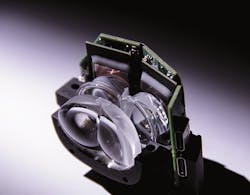Fraunhofer developing microdisplays for headache- and motion-sickness-free VR glasses
Virtual reality (VR) glasses are increasingly popular. Not only are computer fans enthusiastic about them, virtual tours through museums or exhibitions are possible, and prospective purchasers can 'see' the interior of their new car with various color and fabric choices. However, currently available VR glasses are usually heavy and oversized, while the feeling of "being right in the scene" often changes to a feeling of being on the deck of a boat during heavy swell. This 'motion sickness' is caused partly by low frame rates and flickering of the images, and partly by an inappropriate field of view.
The latest research results from the European funded project LOMID (Large cost-effective OLED microdisplays and their applications) is tasked to solve these challenges.
As part of the project, scientists from The Fraunhofer Institute for Organic Electronics, Electron Beam and Plasma Technology (Fraunhofer FEP; Dresden, Germany) have developed new OLED microdisplays with a size of one inch, resolution of 1920 x 1200 pixels (WUXGA, 2300 ppi), and frame rates of 120 Hz. Ultracompact optics, designed by project partner LIMBAK, seamlessly combine two display chips per eye, making four in total for the entire headset. With two WUXGA microdisplays per eye, the headset has a total resolution of 4800 x 1920 pixels, which is close to 5 k. This design facilitates very high effective display resolutions and a wide field of view (> 100 degrees) for an excellent immersive VR sensation.
Moreover, the optics scientists of LIMBAK have been able to decrease the display-to-eye distance needed in the headset, lowering it to only 37 mm (compared to 60-75 mm in most conventional headsets). This ultracompact optical design reduces the headset size to about a quarter of the volume and half the weight of a conventional headset while maintaining the same field of view.
Judith Baumgarten, scientist in the IC and System Design department at Fraunhofer FEP explains the design approach taken to reach high framerates and thus reducing motion sickness effects and flickering in VR applications: "To offer such high framerates of 120 Hz and thus high data rates, we have extended the parallel interface of the OLED microdisplays. The display mode can be configured flexible from hold-type to impulse-type. The latter allows the elimination of motion artefacts and flicker with a special rolling emission mode. The chip also provides special look-up-tables for gamma correction - each channel (red, green, blue, and white) can be calibrated individually. We achieved a superior image quality with a very high contrast ratio of >100'000:1 at extraordinary low power consumption. We are very pleased about these positive results of our displays in combination with the ultra-compact optic design of LIMBAK, which enable really compact VR devices."
The tiling of multiple OLED-on-silicon microdisplays inside the system has helped to reduce its form factor and weight, while increasing resolution to a level not easily achieved by conventional TFT-based AMOLED displays in VR headsets currently due to their typical pixel density limits. This approach also supports keeping yield and thus costs in a reasonable range.
Scientists from Fraunhofer FEP will present a LOMID headset prototype as well as research results during the awe Europe 2018 at booth no. 322, from October 18-19, 2018 at MOC Exhibition Center Munich, Germany.
SOURCE: Fraunhofer FEP; https://www.fep.fraunhofer.de/en/press_media/17_2018.html
About the Author

Gail Overton
Senior Editor (2004-2020)
Gail has more than 30 years of engineering, marketing, product management, and editorial experience in the photonics and optical communications industry. Before joining the staff at Laser Focus World in 2004, she held many product management and product marketing roles in the fiber-optics industry, most notably at Hughes (El Segundo, CA), GTE Labs (Waltham, MA), Corning (Corning, NY), Photon Kinetics (Beaverton, OR), and Newport Corporation (Irvine, CA). During her marketing career, Gail published articles in WDM Solutions and Sensors magazine and traveled internationally to conduct product and sales training. Gail received her BS degree in physics, with an emphasis in optics, from San Diego State University in San Diego, CA in May 1986.
